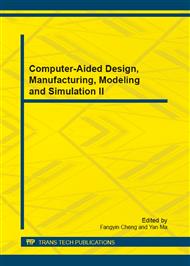p.1194
p.1199
p.1204
p.1209
p.1214
p.1220
p.1226
p.1231
p.1237
The Model and Simulation of Magnetorheological Grease Characteristics
Abstract:
Magneto-rheological grease attracts the attention as a new kind of intelligent material. Under the external magnetic force, it is difficult to use traditional mathematics model to solve and analysis internal structure because of its complexity and polytropy. The modeling and simulation for complex system using computer becomes a good way to investigate complex system. Based on the electromagnetic theory and computer simulation, this paper constructed the model of shear stress to describe the characteristic of magneto-rheological grease that is to use body centered cubic pillars model to analysis the mechanism and characteristics of magneto-rheological grease. Using matlab simulink toolkit to compose the simulation program, simulate and analysis using theoretic model, and plot the shear stress curve of magneto-rheological grease with magnetic strength and particle size, and the shearing force under zero field. The simulation and experimental results indicate that the simulated shear stress curve is coincidence with experimental curve when the density of ferromagnetic particle is low, and it is lower than experimental curve when the density is high (the variation tendency is close), which verified the accuracy of theoretical model. It needs to improve the model by considering the still friction between ferromagnetic particles.
Info:
Periodical:
Pages:
1214-1219
Citation:
Online since:
December 2012
Authors:
Price:
Сopyright:
© 2013 Trans Tech Publications Ltd. All Rights Reserved
Share:
Citation:


